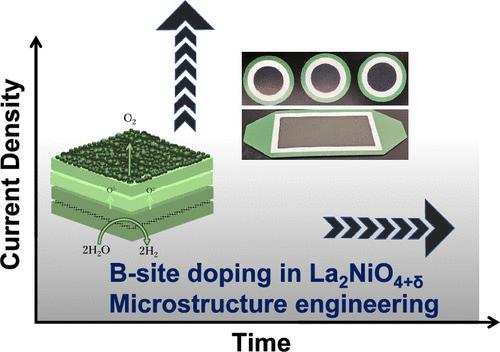Stable Cu-Doped La2NiO4+δ Oxygen Electrodes for Solid Oxide Electrolysis Cells
IF 8.2
2区 材料科学
Q1 MATERIALS SCIENCE, MULTIDISCIPLINARY
引用次数: 0
Abstract
A high-temperature solid oxide electrolysis cell (SOEC) technology is making significant progress toward commercialization, aiming to offer an efficient and cost-competitive path to hydrogen production from water. Improvements in the performance and durability of SOECs are still needed to extend the device’s life. Strontium surface segregation in state-of-the-art Sr-containing oxides, lanthanum strontium cobalt iron oxide (LSCF) and lanthanum strontium cobalt oxide (LSC), and Sr reactivity with air gas impurities, such as chromium (Cr) and sulfur (S), leading to secondary phase formation suppresses the electrode activity. Developing Sr-free oxygen electrodes would alleviate these issues and improve the long-term device operation. In this work, we investigated the performance and stability of copper-doped La2NiO4+δ compositions with the Ruddlesden–Popper structure for oxygen evolution reaction (OER) using small- and large-area planar electrode-supported SOECs. Cells with the La2Ni0.8Cu0.2O4+δ (LNCuO-20) demonstrated a current density of up to 1.2 A/cm2 at 750 °C at 1.3 V when operated in 90% steam in hydrogen versus air for over 1000 h. The materials’ scalability and applicability for practical devices were validated by using 13 cm2 active area cells.

固体氧化物电解电池中稳定的cu掺杂La2NiO4+δ氧电极
高温固体氧化物电解电池(SOEC)技术正朝着商业化的方向取得重大进展,旨在为水制氢提供一种高效且具有成本竞争力的途径。为了延长器件的使用寿命,仍然需要改进soec的性能和耐用性。锶在最先进的含锶氧化物镧锶钴氧化铁(LSCF)和镧锶钴氧化物(LSC)中的表面偏析,以及锶与空气中杂质(如铬(Cr)和硫(S))的反应性,导致二次相的形成,抑制了电极的活性。开发无锶氧电极将缓解这些问题,并改善设备的长期运行。在这项工作中,我们研究了具有Ruddlesden-Popper结构的铜掺杂La2NiO4+δ组合物在小面积和大面积平面电极支撑的SOECs中析氧反应(OER)的性能和稳定性。La2Ni0.8Cu0.2O4+δ (LNCuO-20)电池在750°C、1.3 V条件下,在90%的氢气和空气中工作超过1000小时,电流密度高达1.2 a /cm2。通过使用13 cm2活性面积的电池,验证了材料的可扩展性和对实际设备的适用性。
本文章由计算机程序翻译,如有差异,请以英文原文为准。
求助全文
约1分钟内获得全文
求助全文
来源期刊

ACS Applied Materials & Interfaces
工程技术-材料科学:综合
CiteScore
16.00
自引率
6.30%
发文量
4978
审稿时长
1.8 months
期刊介绍:
ACS Applied Materials & Interfaces is a leading interdisciplinary journal that brings together chemists, engineers, physicists, and biologists to explore the development and utilization of newly-discovered materials and interfacial processes for specific applications. Our journal has experienced remarkable growth since its establishment in 2009, both in terms of the number of articles published and the impact of the research showcased. We are proud to foster a truly global community, with the majority of published articles originating from outside the United States, reflecting the rapid growth of applied research worldwide.
 求助内容:
求助内容: 应助结果提醒方式:
应助结果提醒方式:


